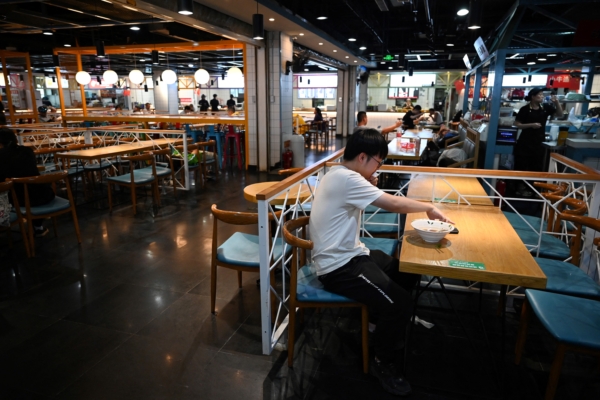Analysis shows that the current efforts of the Chinese authorities to stimulate household spending are too small in scale to bring meaningful changes to the economic model. Following the current trajectory of development, Beijing may soon have to accept the reality of slowing growth.
On July 31, Chinese Premier Li Keqiang presided over an executive meeting of the State Council. The meeting emphasized the need to introduce a batch of “incremental policy measures that are operationally strong, effective, and tangible to the masses and businesses.”
Days earlier, the National Development and Reform Commission of China announced plans to use 150 billion yuan (approximately 20 billion US dollars) in funds from ultra-long-term special national bonds to support the “trade-in for new” program, with a clear focus on household and electric bicycles within the support range.
Analysts pointed out that faced with trade tensions and local government debt risks, the Chinese authorities find it challenging to increase exports or continue massive infrastructure investments. Therefore, in the coming years, they may have no choice but to continue ramping up efforts to stimulate consumption and boost the long-term sluggish domestic demand.
However, the vague promises of the current “incremental policies” in China are likely to fall short of the desired impact.
With the challenges of dumping cheap Chinese goods and Beijing’s strategic ambitions in critical industries, countries including the United States, Europe, Turkey, Brazil, India, Mexico, and Indonesia have begun to raise tariffs on Chinese goods or impose other barriers.
This situation leaves China unable to rely on mass production of inexpensive goods for export-led economic stimulus. Eventually, the focus has shifted towards stimulating consumer demand.
An analyst from Citibank told Reuters, “Facing potentially stronger external unfavorable factors, further stimulus for consumption will still be needed next year.”
Many analysts believe that China’s export prospects may continue to deteriorate, especially if Trump returns to the White House, potentially dealing a significant blow to Chinese export trade. Trump has considered imposing tariffs as high as 60% on all Chinese goods and advocated for revoking China’s Most Favored Nation status.
Yue Su, Chief Economist at the Economist Intelligence Unit (EIU), estimated that a 10% increase in US import tariffs could lower China’s actual economic growth rate in 2025 and 2026 by 0.3 to 0.4 percentage points.
She said, “Increasing external pressure, including the possibility of Trump returning to office, highlights the urgency of stimulating the domestic economy.”
Currently, most of China’s fiscal stimulus policies are still focused on investment, but the returns are diminishing, and these expenditures have burdened local governments with a debt of 13 trillion US dollars. This has forced the Chinese authorities to intensify scrutiny on heavily indebted cities and become increasingly cautious about financing projects.
In the first half of this year, local governments issued special bonds worth 1.49 trillion yuan (approximately 200 billion US dollars) to stimulate the economy and fund specific infrastructure projects.
Reuters pointed out that this amount only accounts for 38% of the annual quota, indicating that in the face of a depressed real estate industry and massive debt pressure, local governments are starting to tighten their finances and cannot participate in economic regulation.
A government economic advisor told Reuters, “Good projects that can bring in stable income are becoming increasingly rare.”
China’s total demand, driven by consumption, investment, and exports, forms the “three engines” that propel economic growth. With China facing tariffs and other barriers on cheap products, and an inability to scale up infrastructure investments, the country must adjust its economic policies to prioritize household consumption.
Nevertheless, China’s current consumption stimulus policies seem to be a drop in the bucket.
Currently, Chinese household spending is less than 40% of GDP, lagging behind most other countries by about 20 percentage points below the global average.
Taking the “trade-in for new” program as an example, the program accounts for only 0.12% of the Gross Domestic Product (GDP). It is challenging to meaningfully rebalance the economy towards consumption and ensure the achievement of this year’s target of around 5% growth.
Christopher Beddor, Deputy Director of China Research at Gavekal Dragonomics, said that to bring consumption back to the trend line before the pandemic, expenditures of 3 trillion to 8 trillion yuan (approximately 400 billion to 1 trillion US dollars) would be needed. But he believes that the Chinese government is unlikely to take such significant stimulus measures.
“Frankly, the authorities’ track record in stimulating consumption is very poor,” he said.
Xu Hongcai, Deputy Director of the Economic Policy Committee of the China Policy Science Research Society, stated that to fully stimulate demand, reallocating 5 trillion yuan from investment projects to consumers may be necessary in the short term.
“In the short term, a stimulus of 5 trillion yuan is powerful,” Xu Hongcai said, “But in the long term, we need to increase the proportion of urban and rural residents’ income to national income by 20 percentage points.”
On Thursday, Huang Yiping, a member of the Monetary Policy Committee of the People’s Bank of China, also criticized China’s economic policies.
In an article, he mentioned that China’s macroeconomic policies are “too mild” and “good at supporting supply but not good at supporting consumption.”
Huang pointed out that China’s economic development has entered a new stage where “total demand, including consumption, exports, and even investment, is no longer as robust as before. This actually poses new challenges to macroeconomic policies.” He suggested that the authorities should abandon the policy concept of “heavy investment, light consumption.”

